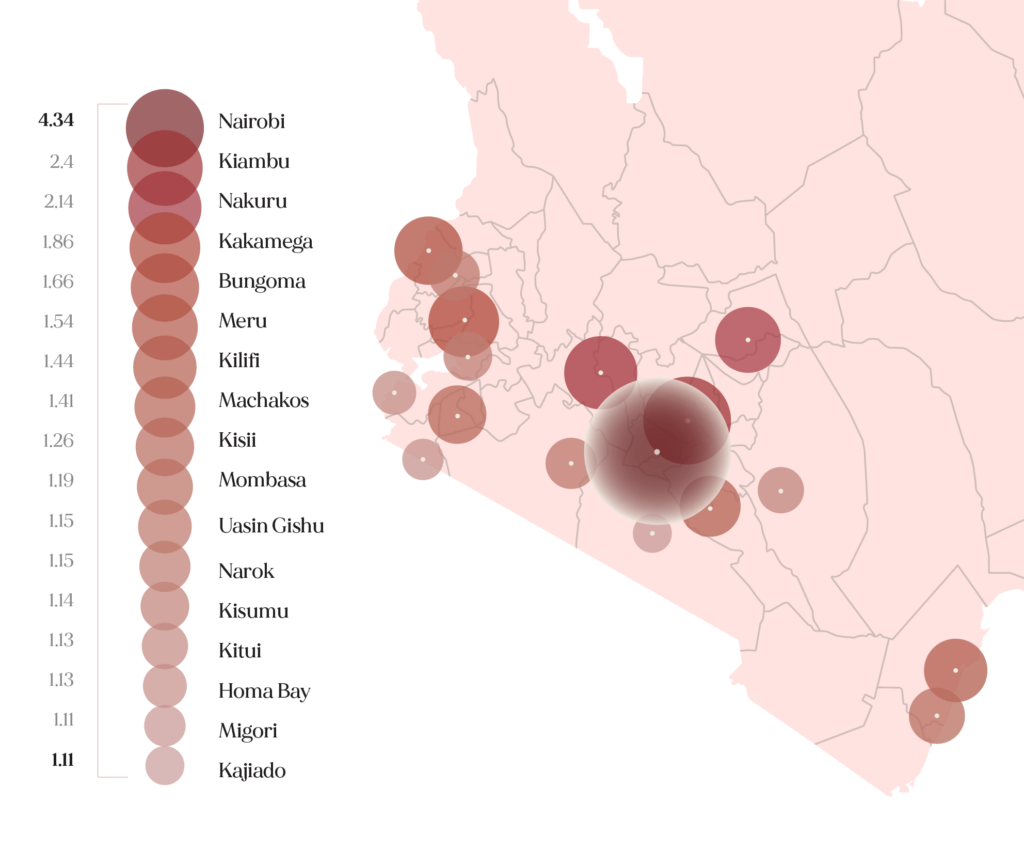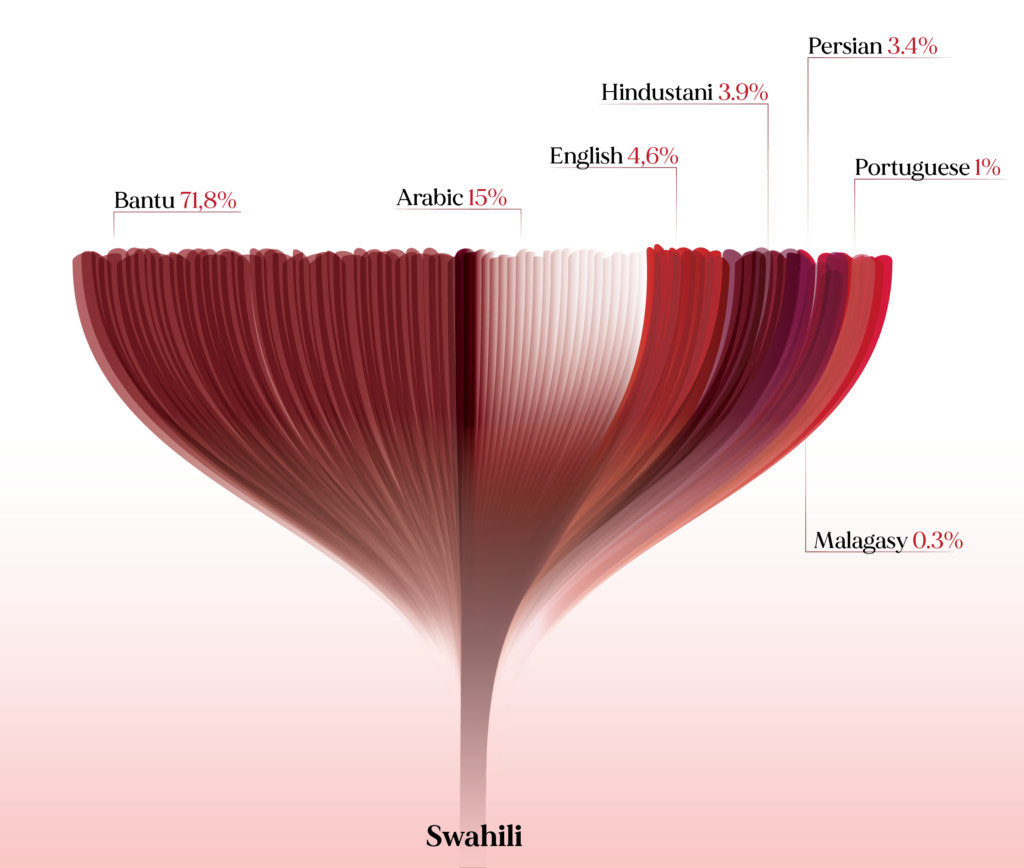Africa
To which language should you translate to localize in Kenya?
What we know from our community
Home to forty-three different ethnic groups, Kenya enjoys incredible ethnocultural and linguistic diversity. It was, therefore, necessary to adopt a common language to enable inter-ethnic communication. Kenya is one of the world’s fifty-five countries with more than one official language. The constitution recognizes both English and Swahili, locally referred to as Kiswahili, as the official languages. Throughout most official communication in Kenya, you will find both languages. All major media stations broadcast national news in English and Swahili. The Kenyan national anthem is sung in both English and Swahili. The Kenyan constitution itself is available in both languages. Swahili, however, is the national language and has been since 1970. Today, nearly all Kenyans speak Swahili making it the country’s most-spoken language. The development of the Swahili language dates back to contact between Arab traders and the coastal people of East Africa. Its use spread inland with time as it was considered the language of trade.
Winnie, Kenyan translator and writer
Swahili
Ikiwa ni nyumbani kwa makabila arobaini na tatu tofauti, Kenya inafurahia uanuwai wa ajabu wa kitamaduni na lugha. Hivyo basi ilikuwa ni lazima kupitisha lugha ya pamoja ili kuwezesha mawasiliano baina ya makabila. Kenya ni mojawapo ya nchi hamsini na tano ulimwenguni ambazo zina zaidi ya lugha moja rasmi. Katiba inatambua Kiingereza na Kiswahili kama lugha rasmi. Katika mawasiliano mengi rasmi nchini Kenya, utapata lugha zote mbili. Vyombo vyote vikuu vya habari vinatangaza habari za kitaifa kwa Kiingereza na Kiswahili. Wimbo wa taifa wa Kenya unaimbwa kwa Kiingereza na Kiswahili. Katiba ya Kenya yenyewe inapatikana katika lugha zote mbili. Kiswahili, hata hivyo, ni lugha ya taifa na imekuwa tangu mwaka 1970. Leo, karibu Wakenya wote wanazungumza Kiswahili hivyo kuifanya iwe lugha inayozungumzwa zaidi nchini. Chimbuko la lugha ya Kiswahili ni pale wafanyabiashara Waarabu walipochangamana na wakazi wa pwani ya Afrika Mashariki. Matumizi yake yalienea ndani ya nchi baada ya muda kwani ilitumika kama lugha ya biashara.
What the 150 top websites do
Of the top 150 website (Global by design ranking):
- 73/150 translate into English.
- 10/150 translate into French.
- 8/150 translate into Portuguese.
- 7/150 translate into Swahili.
- 1/150 translates into Kenyan Sign Language.
If you need others information, below you can find a selection of economic/social/cultural data
Overview
Language
Official language
English, Swahili
T-index
0.094%
T-Index ranks countries according to their potential for online sales.
Other languages
Kikuyu, Luhya, Luo, Meru, Kalenjin, Kamba, Gusii, Mijikenda/Giriama, Nilotic, Dholuo, Maasai, Turkana, Cushitic, Oromo, Borana, Orma, Somali.
Language Minorities
Afroasiatic languages, Cushitic, Rendille, Semitic, Arabic, Indo-European, Hindi, English, Bantu.
English
High proficiency (EF) – 19 of 113 countries/regions in the world- 2/23 position in Africa.
Demography
Capital: Nairobi
Currency: Kenyan shilling
Population: 55.65 milions
Population density: 95.8/km2
Economy
GDP: 113.42 billion USD (2022)
GDP per capita: 2,099.30 USD (2022)
Exports: $7.34 billion (2022)
Statistics
Unemployment rate: 5.7% (2021)
Average age: 19.7
Urbanisation: 29.8% (2024)
Literacy: 82.9% (2024)
Internet users: 40.8% penetration, 22.71 million
Conventions
Numbering system
Arabic numbering system and dot as decimal separator
Date format: yyyy-mm-dd/ dd-mm-yyyy / mm-dd-yyyy
Time: 24h time system
Country code: 00254
Language data sources: Worldatlas/Britannica//EF/Wikipedia; Demography data sources: IMF/Worldometers; Conventions data source: Wikipedia; Economy data sources: WTO/OEC/CIA/Esomar/Datareportal; Statistics data sources: Datareportal/WorldBank/UN/UNESCO/CEIC/IMF/Culturalatlas/Commisceoglobal
Facts and data
Economy
Imports
$25.5 billion (2022). Refined Petroleum ($5.41B), Palm Oil ($1.28B), Wheat ($576M), Packaged Medicaments ($524M), and Cars ($523M), importing mostly from China ($6.55B), United Arab Emirates ($3.6B), India ($2.72B), Malaysia ($1.1B), and Saudi Arabia ($929M).
Financial inclusion factors (over 15 years of age)
• 55.7% have an account with a financial institution
• 5.7% have a credit card
• 72.9% have a mobile money account
• 26% make online purchases
Ease of doing business
It is easy to conduct business (rated 73.2 out of 100) ranked 3rd out of 48 African countries. 56th out of 190 countries worldwide (2020, World Bank).
Global Innovation Index
Ranked 8th out of 27 Sub-Saharan African countries, 100th out of 132 worldwide.
The Global Innovation Index captures the innovation
ecosystem performance of 132 economies and tracks the most recent global innovation trends.
Exports
$7.34 billion (2022). Tea ($1.39B), Cut Flowers ($665M), Coffee ($341M), Titanium Ore ($290M), and Tropical Fruits ($227M), exporting mostly to United States($722M), Uganda ($677M), Pakistan ($541M), Netherlands ($502M), and Rwanda ($439M).
Main local online stores
Jumia, Kilimall, OLX, Pigiame, Cheki, Electrohub, Mimi, Mamamikes, Masoko, MallforAfrica
Economic freedom
‘Mostly not free’ (rated 53.6 out of 100). Ranked 20th out of 47 African countries Ranked 120th worldwide out of 177 countries (2024, Heritage Foundation and Wall Street Journal).
Economy data sources: WTO/OEC/CIA/Esomar/Datareportal

The Challenge of Diversification
What's Imminent In Kenya
Each month, we spotlight a country with its own unique characteristics. Using analytical lens, we explore What’s Imminent in the linguistic, cultural, and economic tapestry to unveil its true character. Join us in this insightful exploration to understand the distinctive dynamics of each region.
Read it now!Service Imports
Service Exports
Source: OEC
Trade balance of goods from 2013 to 2023
Source: Statista
Historical Data Trade Imports
The following section uses historical trade data imports from partners of Kenya.
Historical Data Trade Exports
The following section uses historical trade data exports from partners of Kenya.
Source: OEC
The Top Export Opportunities for Kenya by Relatedness
Relatedness measures the distance between a country's current exports and each product by showing only products that Kenya is not specialized in.
Kenya's Most Complex Exports
The Product Complexity Index (PCI) measures the knowledge intensity of a product by considering the knowledge intensity of its exporters.
Source: Statista
Most Specialised Products by RCA Index
Specialisation is measured using Revealed Comparative Advantage, an index that takes the ratio between Kenya observed and expected exports in each product.
Source: OEC
Market Growth Imports
This score represents the likelihood that the given country will start importing that product in the next few years. It forecasts the opening of a new specific market.
Market Growth Exports
This score represents the likelihood that the given country will start exporting that product in the next few years. It forecasts the opening of a new specific market.
Source: OEC
Foreign direct investment, net inflows (% of GDP)
Source: WorldBank

T-index
Reach most of the online purchasing power
T-Index ranks countries according to their potential for online sales. It estimates the market share of each country in relation to global e-commerce.
Try it nowMedia
Media language English, Swahili
Information channels
Kenya has a lively media scene and a small number of big players dominate the industry. One of them, Nation Media Group, also operates in neighbouring countries. The state-owned Kenya Broadcasting Corporation (KBC) is funded from advertising and a government budget.
Television is the leading medium and free-to-air digital terrestrial TV is the most popular platform. Privately-owned Citizen TV is the top station in terms of audience and revenue. Radio is flourishing and there were 173 licensed stations by the end of 2018, according to the Communications Authority. Entertainment, music and phone-ins dominate their output. Radio is an important medium in rural areas, where most Kenyans live. Many stations broadcast in local languages other than English or Swahili. Full-time FM relays of the BBC World Service are on the air in Nairobi (93.9), Mombasa (93.9) and Kisumu (88.1). The highly-competitive press scene is the most sophisticated in east Africa. Print media are dominated by two publishing houses, the Nation and Standard. Reporters Without Borders (RSF) said in 2019 that Kenya has seen “a slow erosion” of media freedom. It said that the political situation and security concerns have been used as grounds to restrict the freedom to inform. Freedom House said that the government and security forces harass journalists, sometimes prompting self-censorship. A 2018 cyber-crime law has been criticized for criminalizing vaguely-defined offences and for allowing for punitive measures against journalists.
News agency
Kenya News Agency, external – state-owned, English-language
The press
Daily Nation – market-leading daily published by the Nation Media Group
The Standard – privately-owned daily, Kenya’s oldest newspaer
The Star – privately-owned daily
The East African – weekly, published by the Nation Media Group
Taifa Leo – Swahili daily published by the Nation Media Group
Business Today, external – news website
Kenyans, external – news website
Tuko, external – news website
Television
Kenya Broadcasting Corporation (KBC), external – state-owned
Citizen TV, external – private, most-watched network, owned by Royal Media Services (RMS)
Kenya Television Network (KTN), external – private, operated by Standard Group
NTV, external – private, operated by Nation Media Group
K24, external – private, news
Radio
Kenya Broadcasting Corporation (KBC), external – state-owned, networks in English, and Swahili and other indigenous languages
Capital FM, external – national commercial network, music and hourly news
Kiss FM, external – national commercial network, music
Radio Citizen, external – national commercial network
Media data source: BBC
Internet Data
Internet users
40.8% penetration, 22.71 million.
Share of web traffic by device
77.65% mobile phones, 21.64% computers (laptops and desktops), 0.70% tablet devices.
Median speed of mobile Internet connection
21.78 Mbps.
Median speed of fixed Internet connection
9.78 Mbps.
Mobile connection as a percentage of total population: 118.7%
Percentage of mobile connections that are broadband (3G-5G): 93.7%
Most popular web search engines
Google (97.3%), Bing (2.3%), Yahoo (0.18%), DuckDuckGo (0.11%), YANDEX (0.04%), Ecosia (0.03%).
Most used social media
Facebook (36.69%), YouTube (21.91%), Twitter (18.5%), Pinterest (11.1%), Instagram (8.7%), Linkedin (1.32%).
Internet data sources: Datareportal/Statcounter
Social statistics
Life expectancy
62 yrs (2022).
Healthcare Expenditure
4.55%of GDP (2021).
Urbanisation
27.51% (2019)
Education expenditure:
92.5% of GDP.
CO2 emissions
0.4 metric tons per capita (2020).
Class
Political leaders and the wealthy are deferred but there are no castes. In the workplace, staff members with money or connections expect special treatment.
Ethnicity
Every Kenyan is affiliated to a tribe. The local culture is therefore a patchwork composed of approximately 30 representative groups and a large influence from religion. Regional cultures play a part too although it is not major in the larger picture.
Urbanisation
29.8% (2024)
Unemployment rate
5.7% (2021)
Corruption perceptions Index
Kenya scored 31 out of 100, ranked 126 out 180 countries worldwide.
Median age of the population
19.7 years
Literacy
82.9%
Religion
Most Kenyans are Christians. There is a large population of Muslims on the Kenyan Coast. There are also traditional religions coexisting with these two major ones. Many Christians and Muslims have found a way to accommodate both culture and religion, thus changing both the culture and the religion to suit each other. In the workplace: A firm in Mombasa has to take into account Islamic holidays more than a firm in Nairobi.
Gender
Men are regarded as the “first” gender and expect to be treated as such; women are “second”. Women are not supposed to have a voice and if they do voice their opinions publicly, they open themselves up to insult. In the workplace: A woman supervisor has a harder task at work, even when she is supervising other women.
World Happiness Index
Kenya ranked 119 out of 146 countries, with a score of 4.543.
Map of Kenya’s population density, by county (in millions)

Source: Statista
Social statistics sources: WorldBank/UN/UNESCO/CEIC/IMF/Statista
The Data Factbook is a work in progress project. Our community is helping us to fill it up always with new and updated data. Your contribution is precious. If you want to help us, please write your advices at imminent@translated.com
Country Curiosities
The Maasai are one of Kenya’s most popular tribes, as they have preserved many of their ancient traditions. One such tradition is the shaving of the Morans (warriors), an event marking the transition of young Maasai warriors to senior warriors in the community. This event, called Enkipaata, is a once-in-a-lifetime ceremony performed only every ten years. On the day of the ceremony, Morans wear colorful beads in their hair, which is braided and dyed with red ochre. Their faces are also painted red, and they attend the ceremony with sticks, chanting traditional songs. The ritual involves all the aspiring warriors going to a river to wash the colors from their hair and faces before returning to the ceremony site. Here, their heads are shaved, usually by their mothers, and then the Oloibonis (community elders) spit in their faces as a blessing. Any Moran who does not participate in this ceremony is not permitted to marry.
Additionally…
- The last male northern white rhinoceros died in Kenya on March 19, 2018, leaving only two females remaining, thus making the subspecies effectively extinct.
- Kenya is the birthplace of Wangari Maathai, the first African woman to receive the Nobel Prize in 2004 for her contributions to sustainable development, democracy, and peace.
- Kenya boasts a comprehensive network of conservation areas, including 23 national parks and 28 national reserves, emphasizing its commitment to preserving natural heritage and promoting responsible tourism.
- Kenya is a world leader in the production of flowers for sale, particularly roses, with floriculture farms around Lake Naivasha and the Rift Valley playing a significant role in the country’s economy.
- According to recent scientific discoveries, humanity originated in Kenya, specifically in regions such as the Turkana Basin.
- Polygamy is traditional in Kenya, where men historically had five or six wives, and bride prices (paid in money or livestock) are still negotiated with the bride’s father, with higher prices for the first wife.
- The ancient volcano Mount Kenya, from which the country derives its name, is Africa’s second-highest peak at nearly 5,200 meters. Despite its equatorial location, it has 11 glaciers that provide drinking water to much of Kenya.
Language research
Main language families in Kenya

Legend
-
Turkana
-
Kikuyu
-
Kenyan Somali
-
Mijkenda
-
Kamba
-
Maasai
-
Kisii
-
Luo
-
Luhya
-
Kalenjin
Distribution of primary languages spoken at home in Kenya, 2021

Source: Statista
The Origins of Swahili Loanwords

Source: Wikipedia
The geographical distribution of languages that you will find in the maps published in this section is a work in progress. Our community is helping us to fill it up with always new and updated data. Your contribution is precious. If you want to help us, please write to imminent.factbook@translated.com
Photo credit: Amani Nation Unsplash
